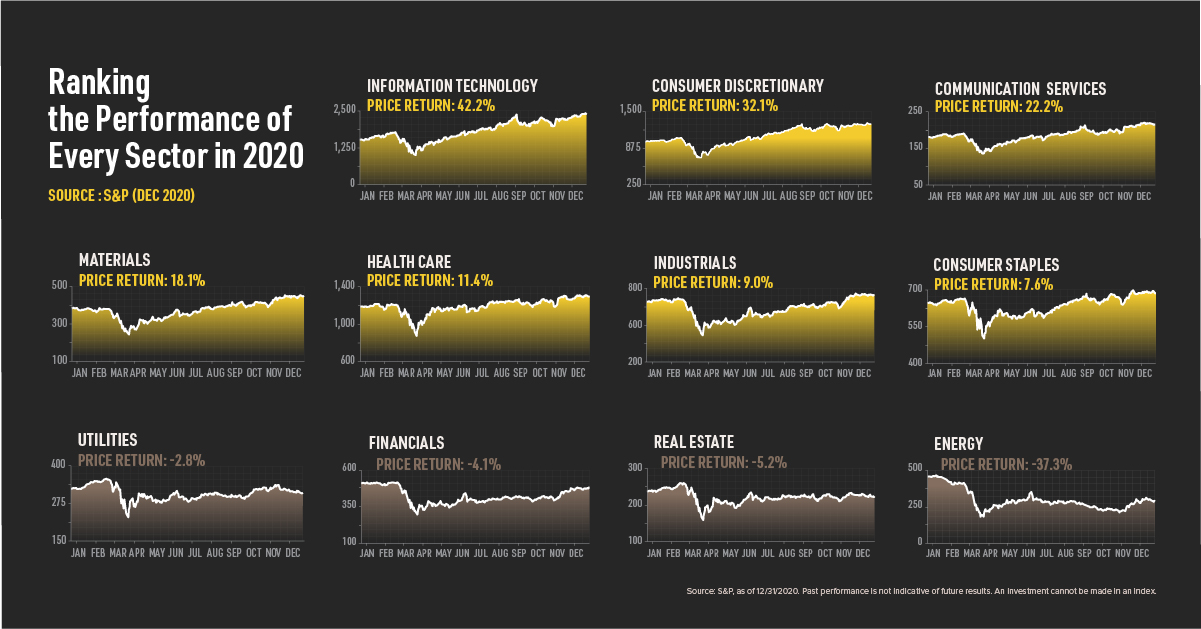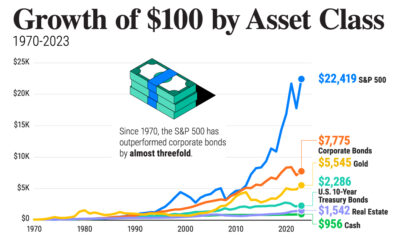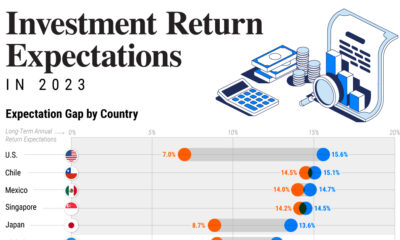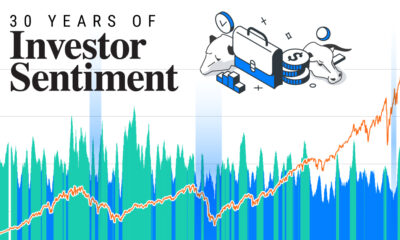Visualizing S&P Performance in 2020, By Sector
With 2020 finally over, many are breathing a sigh of relief.
Investors faced a tumultuous year. Still, the S&P 500 finished strong with a 16% gain, outpacing its decade-long average by 4%. Many sectors that provided the new essentials—like online products, communication software and home materials—outperformed the market. It was, of course, a challenging year for other sectors including energy.
This Markets in a Minute graphic from New York Life Investments ranks the 2020 performance of every sector in the S&P 500 using data from S&P Global.
S&P Performance By Sector
As the world coped with devastating losses and uncertainty, how resilient were S&P 500 sectors?
Here’s how every sector performed, from top to bottom.
| S&P 500 Sector | 2020 Price Return | 2019 Price Return | 10-Year Annualized Returns | P/E (Trailing)* |
| Information Technology | 42.2% | 48.0% | 18.9% | 31.6 |
| Consumer Discretionary | 32.1% | 26.2% | 16.0% | 48.1 |
| Communication Services | 22.2% | 30.9% | 5.6% | 27.5 |
| Materials | 18.1% | 21.9% | 6.6% | 40.4 |
| Health Care | 11.4% | 18.7% | 13.8% | 25.3 |
| Industrials | 9.0% | 26.8% | 9.6% | 28.9 |
| Consumer Staples | 7.6% | 24.0% | 8.7% | 25.1 |
| Utilities | -2.8% | 22.2% | 7.2% | 21.1 |
| Financials | -4.1% | 29.2% | 8.6% | 15.3 |
| Real Estate | -5.2% | 24.9% | 6.6% | 36.3 |
| Energy | -37.3% | 7.6% | -5.6% | N/A |
| S&P 500 | 16.3% | 28.9% | 11.6% | 31.2 |
*Trailing P/E measures market value divided by the last 12 months of earnings
As no surprise, technology came out on top with over 42% returns for the year.
COVID-19’s economic impact benefited the sector as activities, from work to socializing, moved online. In 2020, the tech sector’s returns were more than double its 18.9% average over the last decade.
Consumer discretionary was also one of 2020’s top sectors. Home to online marketplace giants along with electric vehicle companies, it posted a 32.1% return—surpassing its 2019 gains.
With -37.3% returns, energy was the hardest hit of all. Historic demand disruptions, along with OPEC tensions led to sector weakness. Like energy, real estate had a difficult year. Still, after declining 40% in March, by year-end, the sector mostly rebounded with just 5% losses.
Why The Market Had a Strong Year
Looking back, one of the biggest questions baffling investors is: why did the market perform so well? A number of factors, including government stimulus, low interest rates, and vaccine expectations can all help explain some of its behavior.
Government Stimulus
In March, the U.S. government approved a $2.2 trillion CARES-Act relief package, breaking historical records for stimulus. This helped create optimism in the market as individuals, small-businesses and corporations received financial relief.
At the same time, the Federal Reserve extended its “quantitative easing” policies that it introduced in 2008. Quantitative easing is when the central bank buys a number of longer-term securities. This type of measure is designed to boost economic activity through injecting liquidity into the market.
In 2020, the Federal Reserve began purchasing corporate bonds and other assets—on top of treasuries and mortgage-backed securities (MBS)—for the first time ever. In fact, the Federal Reserve is now estimated to 34% of MBS in the U.S. to help protect American homeowners.
Low Interest Rates
Another force that may have contributed to S&P performance in 2020 was the Federal Reserve’s low-interest rate policy.
Low interest rates mean that borrowing costs are low, which can be favorable for business conditions. In September, the Federal Reserve announced a “lower for longer policy”, stating that it won’t raise rates until 2023.
Vaccine Expectations
The promise of a vaccine rollout has contributed to S&P 500 performance momentum, along with expectations that things could return to normal in 2021. It also corresponded with double-digit gains for the health care sector.
Though roadblocks and uncertainties remain, vaccine announcements in November also helped spur an uptick in the energy sector, which will be influenced by global vaccine efforts in the months ahead. This, in turn, will help travel resume to normal and spark oil & gas demand.
S&P Performance: What Comes Next in 2021
With the first year of the pandemic behind us, it’s hard to say how the story will continue.
As countries acquire vaccines, there is hope for S&P 500 performance, and future stimulus measures could prop up the stock market. Of course, both the containment of the virus and people feeling safe will have an outsized impact on S&P sectors in the shift to a post-pandemic world.




 Infographics2 years ago
Infographics2 years ago
 Markets in a Minute2 years ago
Markets in a Minute2 years ago
 Markets in a Minute2 years ago
Markets in a Minute2 years ago
 Infographics2 years ago
Infographics2 years ago
 Markets in a Minute1 year ago
Markets in a Minute1 year ago
 Markets in a Minute2 years ago
Markets in a Minute2 years ago
 Infographics1 year ago
Infographics1 year ago
 Markets in a Minute2 years ago
Markets in a Minute2 years ago



















